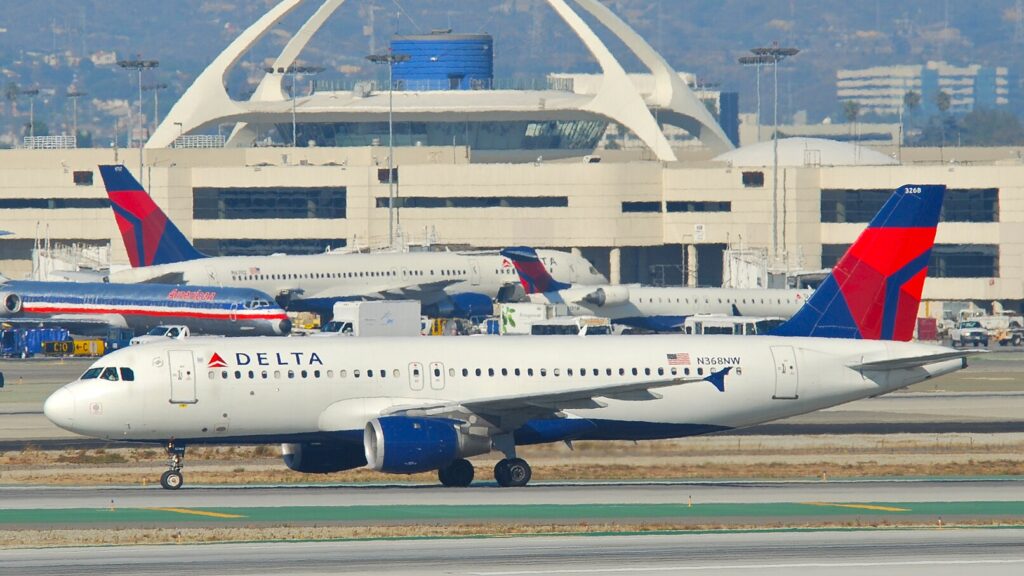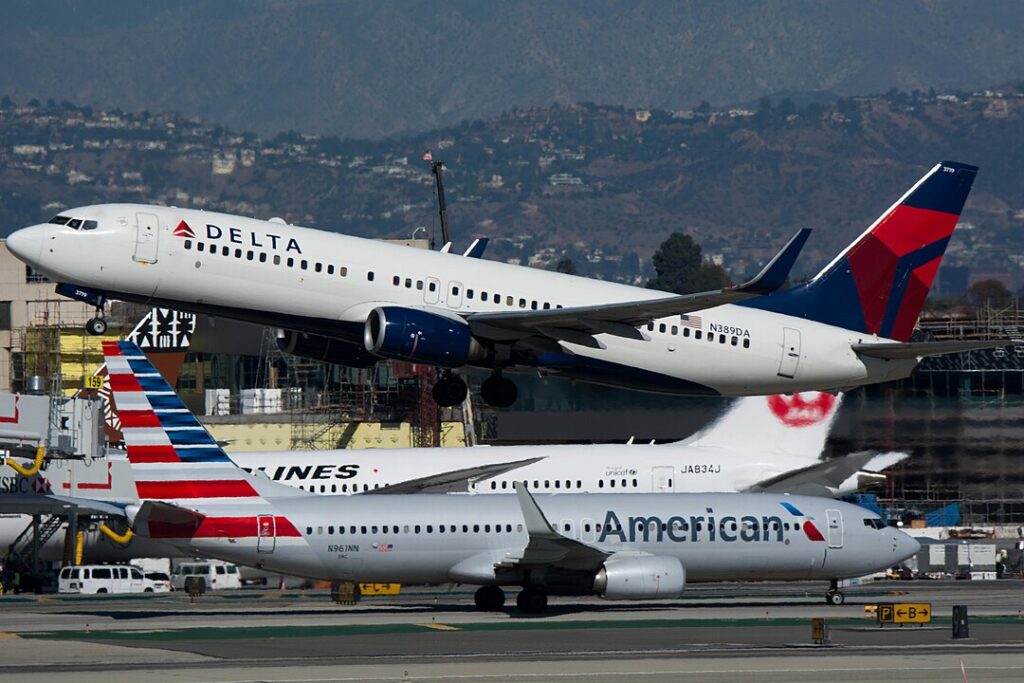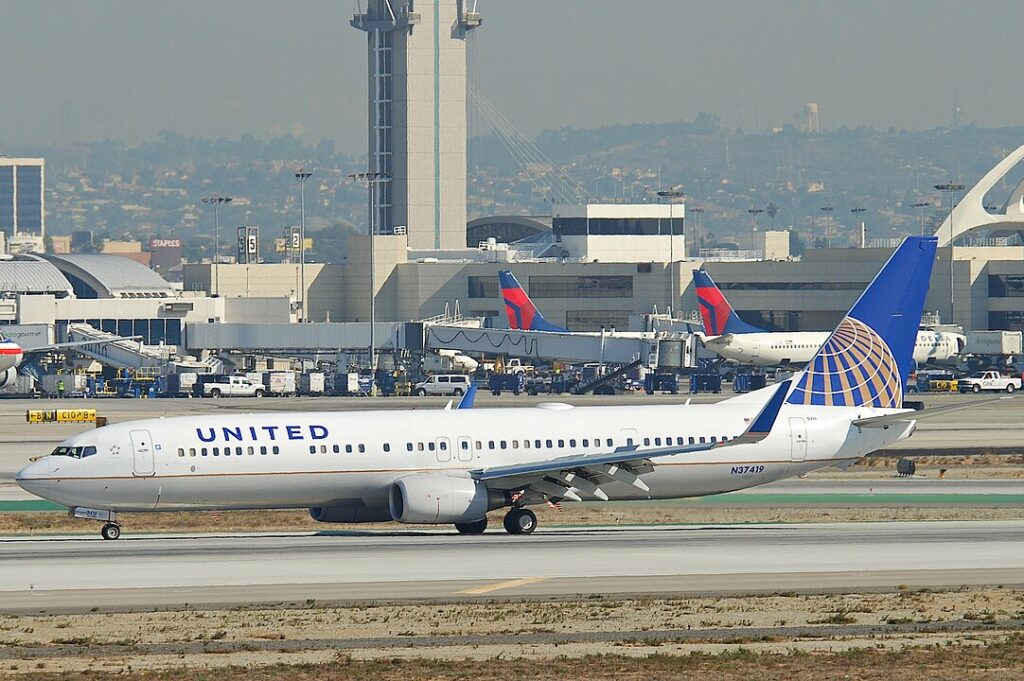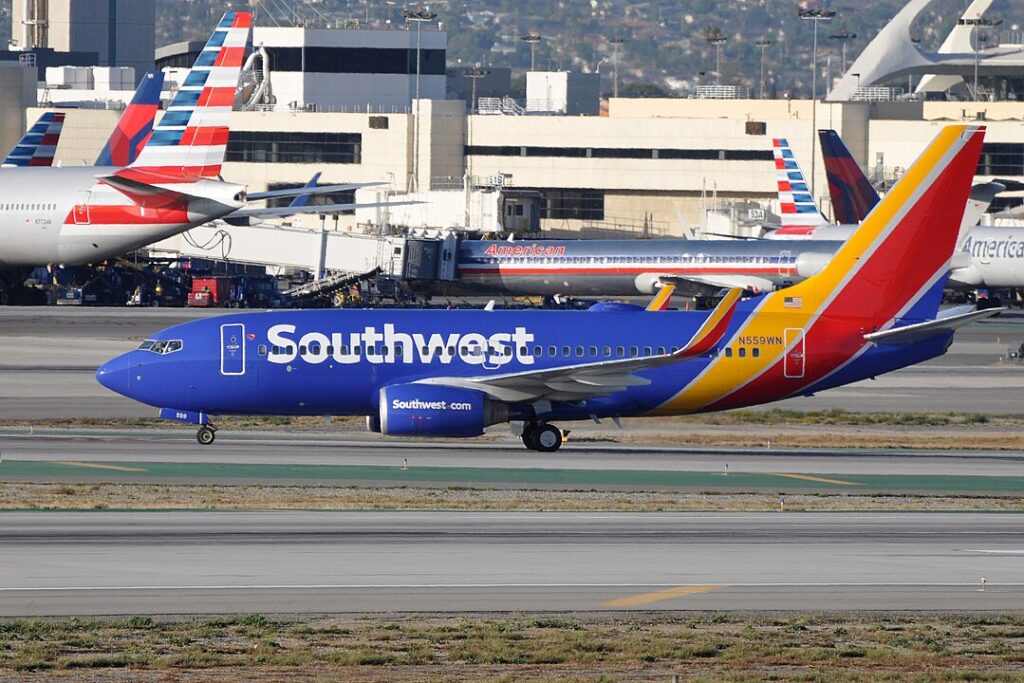
Международный аэропорт Лос-Анджелеса (LAX) является одним из крупнейших аэропортов в США. Главный аэропорт, обслуживающий второй по величине город в США, многие авиакомпании имеют хабы или операционные базы в Калифорнии. Расположенный примерно в 18 милях к юго-западу от центра Лос-Анджелеса, LAX остается самым загруженным аэропортом на Западном побережье.
Это самые важные ворота Америки для транстихоокеанских путешествий. Объект имеет четыре параллельные взлетно-посадочные полосы и управляется аэропортами мира Лос-Анджелеса.
Лос-Анджелес Mega Hub
 Фото: Aero Icarus из Цюриха, Швейцария - Delta Air Lines Airbus A320-212; N368NW@LAX;11.10.2011/623oc, CC BY-SA 2.0, https://commons.wikimedia.org/w/index.php?curid=26712513
Фото: Aero Icarus из Цюриха, Швейцария - Delta Air Lines Airbus A320-212; N368NW@LAX;11.10.2011/623oc, CC BY-SA 2.0, https://commons.wikimedia.org/w/index.php?curid=26712513В 2023 году, за последний год, по которому имеются достоверные данные, через LAX прошло более 75 миллионов пассажиров. Это делает аэропорт восьмым по загруженности в мире. Кроме того, аэропорт является самым загруженным во всем мире для перевозок по месту происхождения, и только 12% пассажиров подключаются через объект.
Аэропорт также является крупным центром для грузовых перевозок. Несколько различных грузовых авиакомпаний имеют хабы в LAX, и он обычно считается одним из пяти самых загруженных аэропортов США для грузовых перевозок.
LAX выделяется среди других аэропортов США во многих отношениях. Однако самым поразительным может быть то, что это единственный аэропорт, который служит центром для всех трех старых авиакомпаний. Но они не единственные перевозчики, работающие в LAX. Давайте более подробно рассмотрим мега-хаб в Лос-Анджелесе, где расположены крупные авиалинии.
Delta Air Lines является крупнейшим перевозчиком LAX по доле рынка
По данным Los Angeles World Airports (LAWA), примерно каждый пятый пассажир, проходящий через объект, является пассажиром Delta. Международный аэропорт Лос-Анджелеса является крупным центром для деловых путешественников. Delta Air Lines, как авиакомпания, специализирующаяся на путешествиях премиум-класса, в значительной степени обслуживает таких путешественников с высокими расходами.
Из LAX Delta обслуживает пункты назначения по всему миру. Он также управляет обширной внутренней сетью от объекта. В результате авиакомпания может эффективно соединять пассажиров из разных пунктов назначения по всей стране. В то же время авиакомпания может эффективно обслуживать рынок Лос-Анджелеса с высоким уровнем расходов, обеспечивая высокое качество обслуживания.
 Представитель Изображение | Фото: Гленн Бельц из Голета, США - DSC_6369, CC BY 2.0, https://commons.wikimedia.org/w/index.php?curid=44952816
Представитель Изображение | Фото: Гленн Бельц из Голета, США - DSC_6369, CC BY 2.0, https://commons.wikimedia.org/w/index.php?curid=44952816Важно отметить, что LAX не является единственным центром дельты на западном побережье. Авиакомпания также имеет крупный международный центр в международном аэропорту Сиэтл-Такома (SEA). Из Сиэтла перевозчик обслуживает многие международные направления в Европе и Восточной Азии, хотя рейсы в Австралию выполняются только из Лос-Анджелеса.
American Airlines является второй по величине авиакомпанией в международном аэропорту Лос-Анджелеса.
Пока дельта У Air Lines есть два разных центра на Западном побережье, у American Airlines только один. (У него есть хаб в международном аэропорту Феникс-Скай-Харбор (PHX), но мало кто будет считать его хабом Западного побережья). В результате авиакомпания направляет большую часть своего трафика в Азию через этот крупный хаб. American Airlines имеет стратегию маршрута, которая включает в себя строительство крупных узлов в американском поясе Солнца, регионе, простирающемся от Флориды до Южной Калифорнии. Центры American Airlines в этом географическом регионе включают:
- Международный аэропорт Лос-Анджелеса (LAX)
- Международный аэропорт Phoenix-Sky Harbor (PHX)
- Международный аэропорт Шарлотта Дуглас (CLT)
- Международный аэропорт Майами (MIA)
- Международный аэропорт Даллас/Форт-Уэрт (DFW)
 Источник: Clément Alloing
Источник: Clément AlloingНесмотря на наличие крупного хаба в LAX, авиакомпания обслуживает относительно небольшое количество направлений в Азиатско-Тихоокеанском регионе. Это связано с тем, что Америка имеет исторически более слабое присутствие на транстихоокеанском рынке, обслуживая лишь несколько городов из своего центра в Лос-Анджелесе. Около 15% пассажиров, проходящих через LAX, находятся на маршруте American Airlines. Региональная дочерняя компания авиакомпании, American Eagle, обслуживает более десятка направлений из центра Южной Калифорнии, включая несколько крупных аэропортов, обслуживающих горнолыжные курорты.
United Airlines имеет вторичный центр на западном побережье в Лос-Анджелесе
United Airlines, третий крупный перевозчик, также имеет хаб в международном аэропорту Лос-Анджелеса (LAX). Тем не менее, в то время как LAX служит основными воротами Западного побережья как для Дельты, так и для Америки, аэропорт, несомненно, является вторым центром на Западном побережье. Из аэропорта United летает в гораздо меньшее количество пунктов назначения, чем из международного аэропорта Сан-Франциско (SFO).
Для большинства пассажиров, путешествующих в Восточную Азию или Австралию на рейсах United, гораздо более вероятно, что вы свяжетесь в Сан-Франциско, чем в Лос-Анджелесе. Авиакомпания LAX в первую очередь стремится обслуживать местный рынок, который является высокооплачиваемым и, следовательно, чрезвычайно прибыльным.
 Фото: Aero Icarus из Цюриха, Швейцария - United Airlines Boeing 737-900ER; N37419@LAX; 10.10.2011/622ha, CC BY-SA 2.0, https://commons.wikimedia.org/w/index.php?curid=26712819
Фото: Aero Icarus из Цюриха, Швейцария - United Airlines Boeing 737-900ER; N37419@LAX; 10.10.2011/622ha, CC BY-SA 2.0, https://commons.wikimedia.org/w/index.php?curid=26712819Однако могут быть некоторые признаки того, что это меняется. В этом году United запустит два новых маршрута, нацеленных на конкурентов, таких как Delta. В мае авиакомпания запустит новые беспосадочные рейсы в Пекинский столичный международный аэропорт (PEK) и Международный аэропорт Торонто Пирсон (YYZ). Обе эти услуги в первую очередь удовлетворяют потребности деловых путешественников. Около 15% пассажиров, путешествующих по LAX, летают по маршруту United.
Последние три перевозчика, которые имеют хабы или работают в международном аэропорту Лос-Анджелеса, не являются устаревшими авиакомпаниями.
Еще три пассажирские авиакомпании имеют большое присутствие в LAX, и, что интересно, трансконтинентальный перевозчик JetBlue не входит в их число. Southwest Airlines, единственная ненаследственная авиакомпания, которая конкурирует с большой тройкой по доле на национальном рынке, имеет операционную базу на объекте. Southwest Airlines летает из Лос-Анджелеса в десятки пунктов назначения по всей стране, и примерно каждый десятый пассажир, проходящий через аэропорт, делает это на юго-западном рейсе.
 Фото: Эрик Салард - N559WN LAX, CC BY-SA 2.0, https://commons.wikimedia.org/w/index.php?curid=44649799
Фото: Эрик Салард - N559WN LAX, CC BY-SA 2.0, https://commons.wikimedia.org/w/index.php?curid=44649799Alaska Airlines также имеет хаб в Лос-Анджелесе. Когда авиакомпания Alaska приобрела Virgin America в 2016 году, основным пунктом продажи сделки было огромное количество посадочных слотов Virgin в LAX. Когда перевозчик смог начать использовать их, он резко расширил свое присутствие в аэропорту и запустил несколько прибыльных новых трансконтинентальных маршрутов.
С долей рынка около 6,5%, Alaska Airlines летает в пункты назначения через Соединенные Штаты, Мексику, Центральную Америку и за ее пределами из своего центра в Лос-Анджелесе.
Последним перевозчиком с операционной базой, о котором важно упомянуть, является ультра-дешевый перевозчик Allegiant Air (G4). Несмотря на свою операционную базу, Allegiant даже не входит в десятку крупнейших авиакомпаний LAX по доле рынка.
Известно, что у оператора есть много небольших баз, с которых он управляет сетью, ориентированной на точки. От LAX Allegiant в основном летает в более мелкие, недостаточно обслуживаемые пункты назначения на Среднем Западе и Горном Западе, а также в других сельских районах Соединенных Штатов.
Оставайтесь с нами. Следуйте за нами в социальных сетях для последних обновлений.
Присоединяйтесь к нам в Telegram Group для последних обновлений авиации. Следуйте за нами в Google News
Топ-10 хабов и основных баз American Airlines
Международный аэропорт Лос-Анджелеса: у каких авиакомпаний есть хабы Там? Впервые появился на Aviation A2Z.













